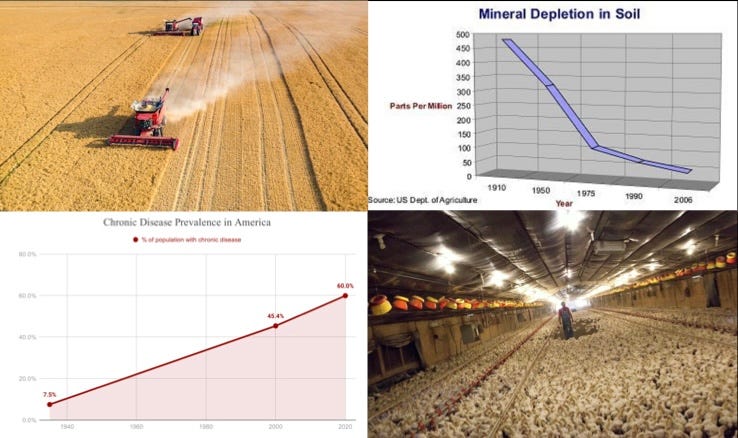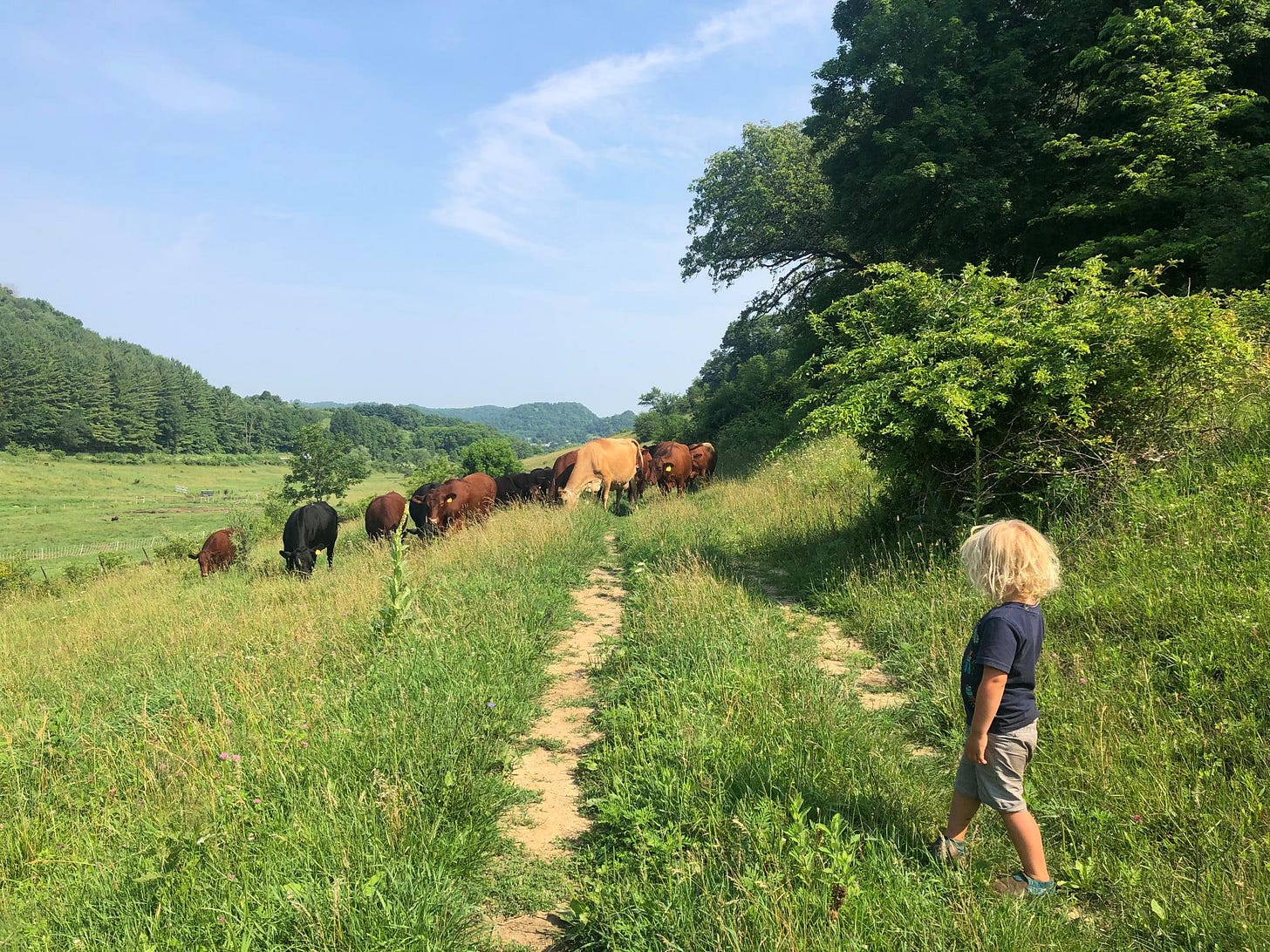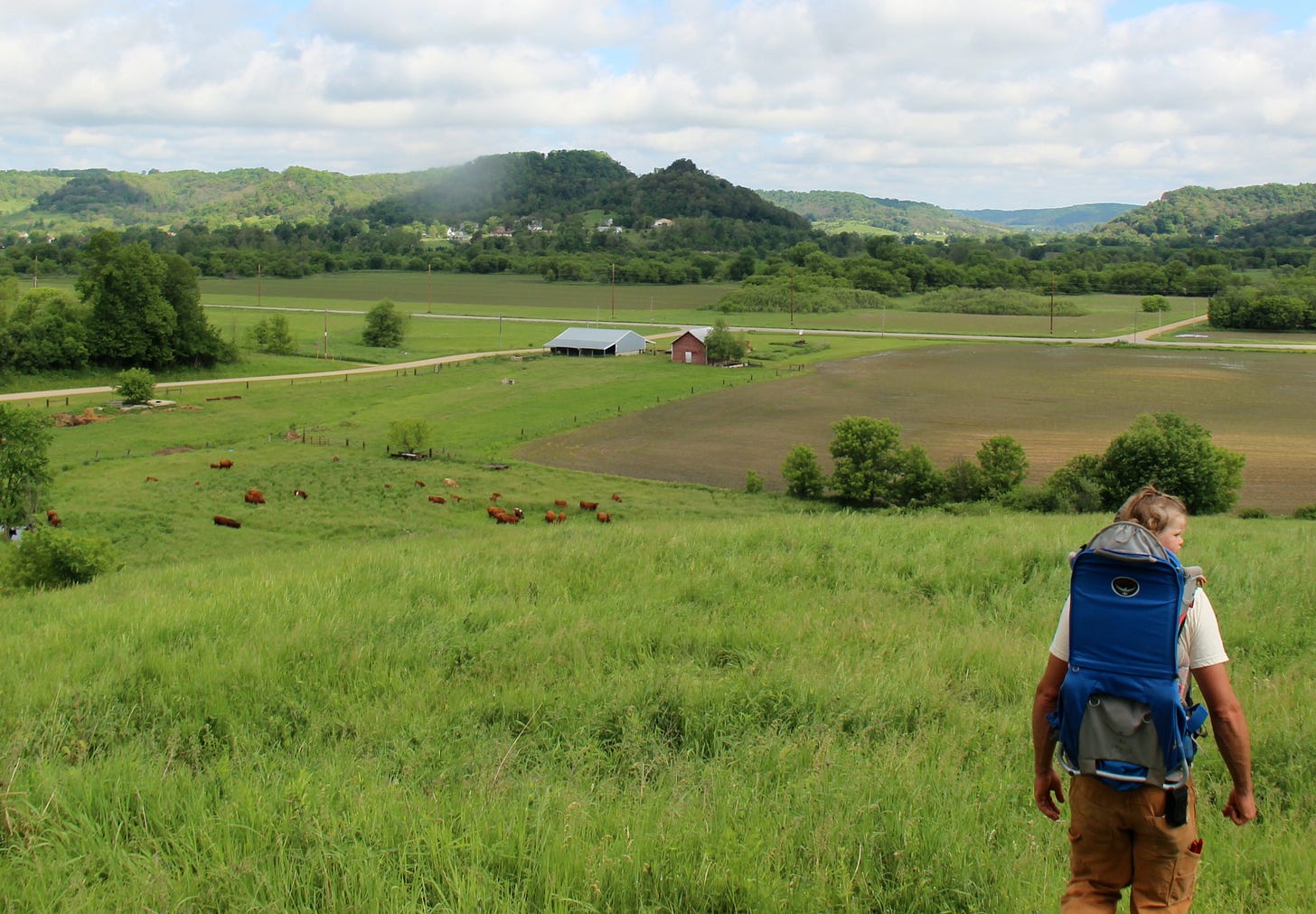Becoming Keystone: An Introduction
There is one solution to the twin catastrophes of collapsing ecosystem and human health unfolding on Earth: Becoming Keystone.
Industrial agriculture has led to the widespread collapse of terrestrial and aquatic ecosystems through conversion to monoculture, tilling, soil erosion, chemical fertilizer and pesticide use, excess nutrient loads, overgrazing, and biodiversity eradication. These lost ecosystems used to provide us with fertile soil, nutrient-dense foods, clean water, clean air, and a stable climate. Their loss means we instead use fossil energy and industrial technology to manufacture fertilizers to grow crops, filters to clean the water, scrubbers to remove pollutants from the air, pharmaceuticals to stave off illness, and even geo-engineering to hubristically attempt to stabilize the climate. While these strategies may allow humanity to physically survive in the short term, they meanwhile destroy our health, well-being, and dignity.
Meanwhile, obesity and chronic diseases are ravaging human health. The exponential rise of chronic disease, obesity, and cancer, while providing an economic boon to the health care industries, are stripping communities of their health, wealth, and futures. These twin crises are intimately related.
The foods we consume are no longer capable of supporting robust human health.
The mineral content of food has plummeted due to modern agricultural practices that destroy the micro-organisms responsible for transporting soil minerals and maintaining healthy plants. As a result, weak plants require copious quantities of herbicides and fungicides to stay alive, coating our foods with poisons. We no longer drink fresh rain or spring water, filtered by the sky or by the Earth. Instead, we drink water municipally treated with chlorine to bleach our guts, fluorine to dull our minds, and containing residues of the many pharmaceutical drugs we require to survive our poisoned air, water, and food. This vicious cycle of sickness may eventually require humans to accept novel nanobot and RNA technologies to survive - pushing us squarely into transhumanism.
For some, this sounds like an exciting future. It will certainly be profitable for many technology and health care companies. For me, it sounds like hell on Earth. A complete loss of what it means to be human.
We must restore functional ecosystems on Earth for a healthy and dignified human future
This is the fundamental premise that drives my work. I spent ten years working on a Masters Degree and PhD at UW-Madison researching ecology, complex systems theory, and restoration. For the past 12 years, I’ve run Mastodon Valley Farm, a 220 acre regenerative farm in Southwestern Wisconsin, putting theory to practice, planting trees, restoring prairie, and grazing cows, sheep, goats, pigs, and poultry. I also teach, design, and consult with farmers and landowners working to implement regenerative practices on their landscapes.
Functional ecosystem are diverse, resilient, and productive landscapes with trophic structure and complex food webs regulated by keystone species. Trophic structure simply means that the energy from the sun is first captured by plants and then continues further transformation through herbivores and predators. All functional ecosystems contain at least one keystone species, whose removal would precipitate a change to a completely different ecosystem state.
It is imperative that humans rapidly figure out how to restore and regenerate functional ecosystems on Earth.
The good news is that we know the basic biophysical theory and practices necessary to restore most ecosystems in ways that produce healthy and nutrient-dense foods.
The grassland and savanna ecosystems that covered North America prior to European arrival were some of the most highly functional ecosystems on the planet. The diverse and perennial cover of grasses and flowers holds on to and in fact rapidly builds topsoil. The massive reserves of topsoil across the Midwest that have constituted the world’s most productive agricultural lands for the last 150 years is due to thousands of years of the soil-building activities of humans burning and bison and elk grazing the tall grass prairie and savanna. In addition to soil building and carbon-sequestration, these grassland ecosystems allow rain water to slowly percolate into the ground, filtering clean and maintaining massive fresh groundwater reserves. Ecosystems with deep topsoil and fresh groundwater reserves are much more resilient to drought. The grasses and flowers themselves provided food for an astonishing volume of herbivores, especially bison, elk, antelope, and deer. Groves of trees in the savanna produced nuts and fruit and provided habitat for many species of birds, insects, and mammals. These trees scattered across the savanna grasslands, resulted in some of the most diverse, productive, and functional ecosystems on Earth.
Regenerative agricultural systems that restore the structure and function of the savanna ecosystems are incredibly productive and are ultimately capable of feeding, nourishing, and healing our populations.
But there are two big roadblocks in the way.
First, our economy is backwards, upside down, and inside out. Policies, structural incentives, and customer expectations all support an insane industrial system and make it nearly impossible for sane, regenerative systems to compete.
Second, and perhaps most importantly, we are stuck in an old paradigm. Our way of seeing the world has been corrupted by the Machine. The Machine paradigm sees the world as simple, linear, predictable, and controllable. It sees nature as separate from humanity and thus seeks to exact control over her. And that is a problem. Because the solution to the twin crises of collapsing human and ecological health is that humans must consciously become a part of nature.
The savanna ecosystems present in North America for the last 10,000 years were managed by Native Americans as agricultural ecosystems. Natives were the keystone species whose activities of burning, manipulating herds of herbivores, and planting trees fundamentally changed the ecology of North America making it more diverse and functional than it would be been in their absense. Prior to the presence of humans, however, megafauna like mastodons were the keystone species of widespread savanna ecosystems. Their activities of browsing and knocking over trees kept forests at bay and created habitat for the diverse grazing animals such as the horses and camels that once occupied our continent.
Savanna ecosystems absolutely require a keystone species to exist.
For 20 million years that was the mastodon. For the last 10,000 years it was Native Americans. Now those ecosystems are gone, their restoration is critical for our survival, and human beings are the only species on Earth capable of restoring the savannas.
If we let the land go and give it “back to Nature,” the land will not magically revert to highly diverse, functional, and productive ecosystems. In Eastern North America, such “Nature preserves” grow up into a climax forest with relatively low diversity, poor ecological functioning, and produce little food.
The idea that we must remove humans from nature to heal the earth is a result of that malignant Machine paradigm that sees humans as separate.
We are a part of Nature, whether we like it or not.
We have proven that our species is capable of destroying the Earth.
But we are also proving that our species is capable of co-creating Paradise on Earth.
But we must take full responsibility for our ecological footprint and Become Keystone.
The Becoming Keystone Substack
This Substack will be a mix of theory, philosophy, ecology, and personal anecdotes that explore the following themes:
What it mean to be Keystone Species
Staying Human in the Age of the Machine
Savanna ecology as a platform for regenerative agriculture
Elements of a New Paradigm
Connections between ecosystem and human health
Regenerative principles and practices
Regular updates from Mastodon Valley Farm
I will post essays and updates at least two or three times per month. I hope to share stories that inform and inspire those on the path of reclaiming personal sovereignty and health, and restoring the bountiful life that surrounds us.




